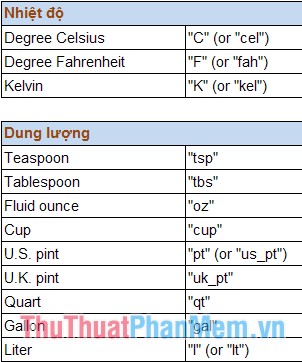Summary of technical functions in Excel
The following article introduces in detail the technical functions in excel.
1. CONVERT function
Description: The function converts back and forth between measurement units. For example, converting units in weight, mass, length, time, energy .
Syntax: CONVERT (number, from_unit, to_unit) .
Inside:
- number: the value you want to convert.
- from_unit: The original unit of value you want to convert.
- to_unit: The unit of measurement you want to convert to.
For example: Convert (5, g, ozm): Convert 5g to Ounce mass units.
Standard for writing conversion units:




2. BESSELI function
Description: Returns the BESSELI function of the In (x) transform.
Syntax: BESSELI (x, n) .
Inside:
- x is the value to calculate the Besseli function.
- n is the order of the function, if n is a decimal number => the function takes the rounding value of n.
Attention:
- If n function returns the value #NUM!
- x, n must be numeric values if entered incorrectly => #VALUE error message.
Example: BESSELI (2.5,3) => Variable Besseli function In (x) first order at value 1.5 => result = 0.47437.
3. The BESSELJ function
Description: Returns the BESSELJ function of the variable Jn (x).
Syntax: BESSELJ (x, n) .
Inside:
- x is the value to calculate the Besselj function.
- n is the order of the function, if n is a decimal number => the function takes the rounding value of n.
Attention:
- If n function returns the value #NUM!
- x, n must be numeric values if entered incorrectly => #VALUE error message.
For example: BESSELJ (2.5,3) => The Besselj function transforms first-degree jn (x) at value 1.5 => result = 0.2166.
4. The BESSELK function
Description: Returns the BESSELK function of the Kn (x) transform.
Syntax: BESSELK (x, n) .
Inside:
- x is the value to calculate the Besselk function.
- n is the order of the function, if n is a decimal number => the function takes the rounding value of n.
Attention:
- If n function returns the value #NUM!
- x, n must be numeric values if entered incorrectly => #VALUE error message.
Example: BESSELK (2.5,3) => Variable Besselk function In (x) first order at value 1.5 => result = 0.268227.
5. BESSELY function
Description: Returns the BESSELY function of the variable Yn (x).
Syntax: BESSELY (x, n) .
Inside:
- x is the value to calculate the Bessely function.
- n is the order of the function, if n is a decimal number => the function takes the rounding value of n.
Attention:
- If n function returns the value #NUM!
- x, n must be numeric values if entered incorrectly => #VALUE error message.
For example: BESSELY (2.5,3) => The Bessely function transforms Yn (x) first order at the value 1.5 => result = -0.75605.
6. The BIN2DEC function
Description: The function performs conversion of binary numbers to decimal numbers.
Syntax: BIN2DEC (number) .
Inside:
number is the value to convert.
Note: If number is more than 10 characters => function value returns an error! NUM.
7. DEC2BIN function
Description: The function performs conversion of decimal values to numbers in binary.
Syntax: DEC2BIN (number [, places]) .
Inside:
- number is the value to convert, places arbitrary parameters.
- places is the number of characters you want to use in the return value.
8. The BIN2HEX function
Description: The function performs a number conversion from binary to hexadecimal.
Syntax: BIN2HEX (NUMBER [, PLACE]) .
Inside:
- Number is the binary value you want to convert.
- Place (the arbitrary value): is the number of characters of the returned result, if omitted excel, get the minimum number of characters enough to return the result.
Attention:
- Place is a natural and non-negative numerical value.
- If the value you want to convert is more than 10 characters => the #NUM !.
- If the conversion value is negative, the function ignores the place parameter and returns the result with 10 characters in hexadecimal.
- If the result has a larger number of characters than the specified in place => error #Num!
- If you enter place as a decimal value, get the integer part of the place.
9. Ham HEX2BIN
Description: The function performs conversion of numeric values from hexadecimal to binary.
Syntax: HEX2BIN (number [, place]) .
Inside:
- number is the value you want to convert.
- place: arbitrary value, specifying the number of characters of the returned result.
Attention:
- Enter the number value in quotation marks eg HEX2BIN ("F").
10. BIN2OCT function
Description: The function converts binary numbers to octal numbers.
Syntax: BIN2OCT (number [, places]) .
Where: number is the value you want to convert, place is an arbitrary value that is the number of characters of the returned result.
Note: Notes are similar to the above functions.
11. OCT2BIN function

Description: The function converts numbers from octal to binary.
Syntax: OCT2BIN (number [, places]) .
Inside:
- number is the value to be converted.
- places: number of characters of the returned result, arbitrary parameters, if omitted excel, the minimum value is sufficient to denote the result.
Note: Notes are similar to the above conversion functions.
12. Ham COMPLEX
Description: The function converts real and imaginary factors into complex numbers of the form x + yi or x + ỵ.
Syntax: COMPLEX (real_num, i_num [, suffix] .
Inside:
- real_num: real coefficient is a numerical value.
- i_num: The imaginary coefficient is a numerical value.
- suffix: suffix of virtual coefficient of complex number if ignoring default is i, if not put in quotation marks.
Note: If 1 of 2 real_num and i_num values are not numeric => #Value error. Or, in case of input suffix outside the characters i and j, the error function #Value.
13. The DEC2OCT function
Description: Convert decimal numbers to octal numbers.
Syntax: DEC2OCT (number, places) .
Inside:
- number: is the decimal number to be converted to octal.
- places: is the number of characters of the returned result. If you enter places, the return result contains the leading zero if the result has fewer characters than places.
Attention:
- If number> 536,870,911 or number <-536870912, or places exceeds 40 characters or places the #NUM!
- If number, places are not numbers => the error message #VALUE!
14. The DELTA function
Description: Check if the 2 numbers are equal or not.
Syntax: DELTA (number 1, number 2) .
Inside:
- number1: is the 1 comparison value.
- number2: is the second comparison value.
If two values are equal => the value of the function returns 1, otherwise it returns 0.
Note: 2 values must be numeric values, if the error value type is entered in the #VALUE error function.
15. GESTEP function
Description: How the function is used to compare 2 values.
Syntax: GETSTEP (number, step) .
Inside:
- number is the value to compare.
- step: value to compare.
If number> step => GETSTEP returns 1, otherwise number
Attention:
- If you do not enter the test value, step by step the function automatically understands the value of step = 0.
- The two parameters of the function must be a numeric value otherwise the #VALUE error function will be displayed.
16. The IMAGINARY function
Description: The function returns the imaginary coefficient of a real number in a complex coefficient.
Syntax: IMAGINARY (number) .
Inside:
- number is a complex number to get a virtual coefficient.
17. IMDIV function
Description: The function performs the quotient of 2 complex numbers.
Syntax: IMDIV (inumber1, inumber2) .
Inside:
- inumber1 is the first complex number to be calculated.
- inumber2 is the second complex number to be calculated.
18. IMLN function
Description: The function performs the natural logarithm of a complex number.
Syntax: IMLN (inumber) .
Inside:
- inumber is a complex number that needs to be calculated naturally.
19. The IMLOG2 function
Description: The function performs base 2 logarithms of a complex number.
Syntax: IMLOG2 (inumber) .
Inside:
- inumber is a complex number to be calculated base 2's logarithm.
20. IMPRODUCT function
Description: The function performs the product of the product of 2 complex numbers.
Syntax: IMPRODUCT (inumber1, inumber2, inumber3, .) .
Inside:
- inumber are complex numbers to calculate.
Note: Complex numbers entered in quotation marks.
For example, IMPRODUCT ("3-2i", "24-9i").
21. IMSIN function
Description: The function performs calculating the sine value of a complex number.
Syntax: IMSIN (number) .
Inside:
- number is a complex number to be calculated.
22. IMSUB function
Description: The function performs the difference of two complex numbers.
Syntax: IMSUB (inumber1, inumber2) .
Inside:
- inumber1 is the first complex number.
- inumber 2 is the second complex number.
23. The IMABS function
Description: Calculate the absolute value of a complex number.
Syntax: IMABS (inumber) .
Inside:
- inumber is a complex number that needs absolute value calculation.
24. IMEXP function
Description: The function performs exponentiation e of complex numbers.
Syntax: IMEXP (inumber) .
Inside:
- inumber is a complex number whose base power is to be calculated e.
25. IMCOS function
Description: Perform the cosine calculation of a complex number.
Syntax: IMCOS (inumber) .
Inside:
- inumber is a complex number for cosine.
Note: The value of entering a complex number is enclosed in quotation marks.
26. IMLOG10 function
Description: The function performs base 10 logarithms of a complex number.
Syntax: IMLOG10 (inumber) .
Inside:
- inumber is a complex number to be calculated base 10 logarithms.
27. IMPOWER function
Description: The function performs exponentiation of a complex number.
Syntax: IMPOWER (inumber, number) .
Inside:
- number is a complex number for exponentiation, number is exponent.
28. The function IMREAL
Description: The function that performs the calculation returns the real coefficient of the complex number.
Syntax: IMREAL (inumber) .
Inside:
- inumber is a complex number to find the real coefficient.
Note: Enter a complex numeric value in quotation marks.
For example: IMREAL ("15-6i").
29. IMSQRT
Description: The function performs the square root of a complex number.
Syntax: IMSQRT (inumber) .
Inside:
- inumber is a complex numerical value to calculate square root.
30. IMSUM function
Description: The function performs calculations and returns the total value of 2 complex numbers.
Syntax: IMSUM (inumber1, inumber2, inumber3, .) .
Inside:
- inumber is complex numbers to be calculated with complex numbers to calculate up to 29 numbers.
 Create a border around Word documents
Create a border around Word documents Set the default file type when saving Word documents
Set the default file type when saving Word documents Invaluable keyboard shortcuts in Excel
Invaluable keyboard shortcuts in Excel Instructions for installing default fonts in Word, Excel and PowerPoint
Instructions for installing default fonts in Word, Excel and PowerPoint Restore unsaved text in Word, Excel, PowerPoint
Restore unsaved text in Word, Excel, PowerPoint Common errors in Microsoft word and how to fix it
Common errors in Microsoft word and how to fix it